
![]()
|
|
BostonWhat I didn't realize is that no sane local person drives in Downtown Boston. Instead, the streets are completely filled with out-of-state visitors in rental cars who are driving around in a state of total confusion. Well, perhaps I'm projecting a bit from my own experience. I did get so far as Chinatown at one point, and picked up some nice statues at a little shop there; and at one point, I thought I was in the West End. It must have been around there that a police officer pulled me over for making a right turn against a red light. He took pity on me however, and wrote up a warning instead of a ticket. Sometime after that, when it was really getting dark, I found out that I had actually ended up miles out of the way in Beacon Hill. My Boston map was of no help during all this, as the thing showed only the most major streets, and so never included any of the names from nearby street signs when I stopped to orient myself. Local people were very kindly and sympathetic in giving directions, but I was never able to proceed very far before getting lost again. Finally I was able to buy a more detailed map and escape to the airport to turn in my rental car. My days thereafter were to be occupied by the business conference that formed the original purpose of my trip. However, I was able to sneak out at 6:00 one morning and walk from my hotel in Cambridge to the North End. It was a fine morning with a cool breeze blowing across the Charles River-I kept thinking that the nickname "Windy City" should have been saved for Boston. Dozens of energetic and determined-looking young people were running along beside the river in the dawn. Out on the water, boat crews were rowing gamely along, urged onward by tyrannical megaphone-wielding characters in motorboats. |
||
|
Across the river after a few blocks I came to the start of the North End, an old colonial area that at some point transformed into a Little Italy. As if to emphasize the fact, the first building I saw on the border had a rich Italianate mural featuring some kingly or papal character painted on its old brickwork. From Lovecraft's tale Pickman's Model you would expect the North End to be a slum, and probably not a safe place to visit:
|
||
Battery Street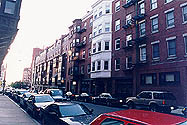
|
But to all appearances it is now considerably gentrified. The buildings must be the same old tenements that Lovecraft saw, but the cars parked out front tend to be distinctly upscale. I followed Commercial Street to Charter Street, and meandered around the area enough to view a number of the narrow, winding alleyways that Lovecraft describes:
|
|
Greenough Lane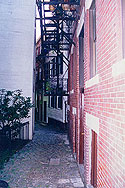
|
One notable example of such is Greenough Lane, which is mentioned in the
story: "I can't tell you which cross street we turned up, but I
know it wasn't Greenough Lane . . ." Surely it is too narrow to even deserve a street name.
Some similar alleys nearby are indeed nameless and do not appear on street maps. |
Nameless Alley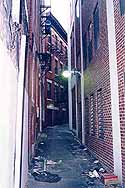
|
Foster Street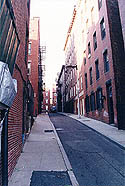 |
A slightly wider side street is Foster Street. A small court adjoining this street is identified by Eckhardt as the location of Pickman's studio, but it isn't at the end of two narrow alleys as described in the story. Also, it seems like too large and open an area for the role. Currently it serves as an open parking area. (Donovan Loucks cautions me that it may have been different in H.P.L.'s time.) |
|
A Passageway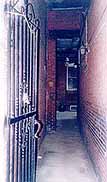 |
A small passage leading to a courtyard. "From that alley, which had a dim light, we turned to the left into an equally silent and still narrower alley with no light at all . . ." | |
An Old Court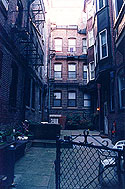
|
An old court: not Foster Court, but suitably atmospheric as a site for Pickman's studio. |
Another View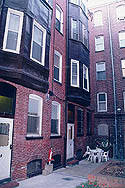
|
Antique Doorway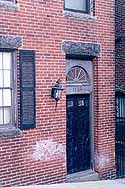
|
"An antediluvian ten-panelled door that looked damnably worm-eaten . . ." A couple of quaint and ancient-looking doorways on Foster Street that certainly give the visual impression you would expect for Pickman's studio. |
Another Doorway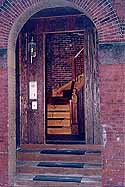
|
Copp's Hill Burial Ground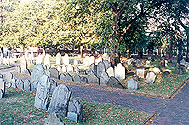
|
Nearby was Copp's Hill Burial ground, one of Pickman's favorite scenes and, it is hinted, one of his favorite dining places. It is cleverly designed to ward off tourists. The gate on the Charter Street side was locked, with a sign stating that is would be closed until April and that one should use the Hull Street entrance instead; but the entrance on Hull Street was locked also. Next to it was a sign warning that is against city ordinances to walk dogs inside, since they do doggy things like peeing on the tombstones and digging holes. I returned to the Charter Street entrance, where the fence was lower. Another sign there warns against doing gravestone rubbings because, even if done carefully, they damage the stone. I adopted a respectful and caring attitude as I hopped the fence to get inside. I was the only one there as I toured the blackened stones. It was the last cemetery I was to visit in New England, and the last of my Lovecraftian sight-seeing. |
|
|
Contents Previous: Providence Next: Conclusion Return to Cthulhu Mythos home page Send comments to jfm.baharna@gmail.com © Copyright 1997-2021 by Joseph Morales |
||